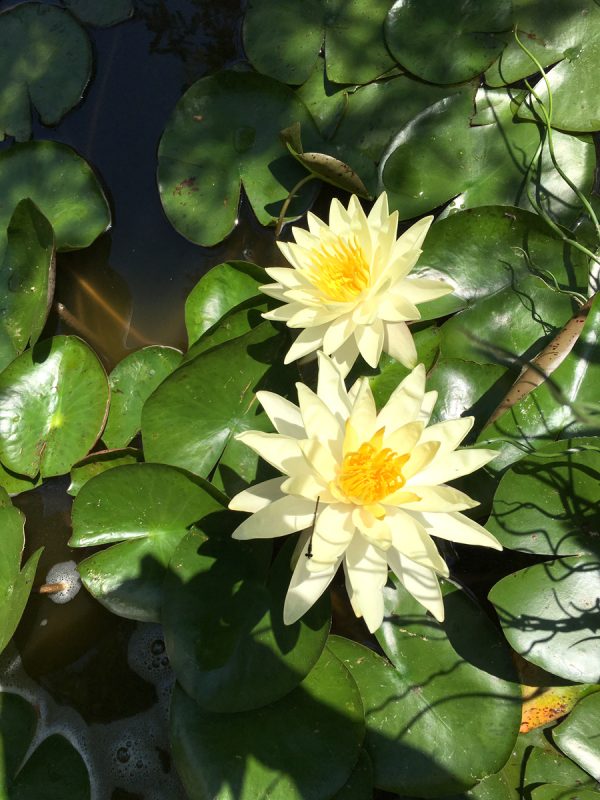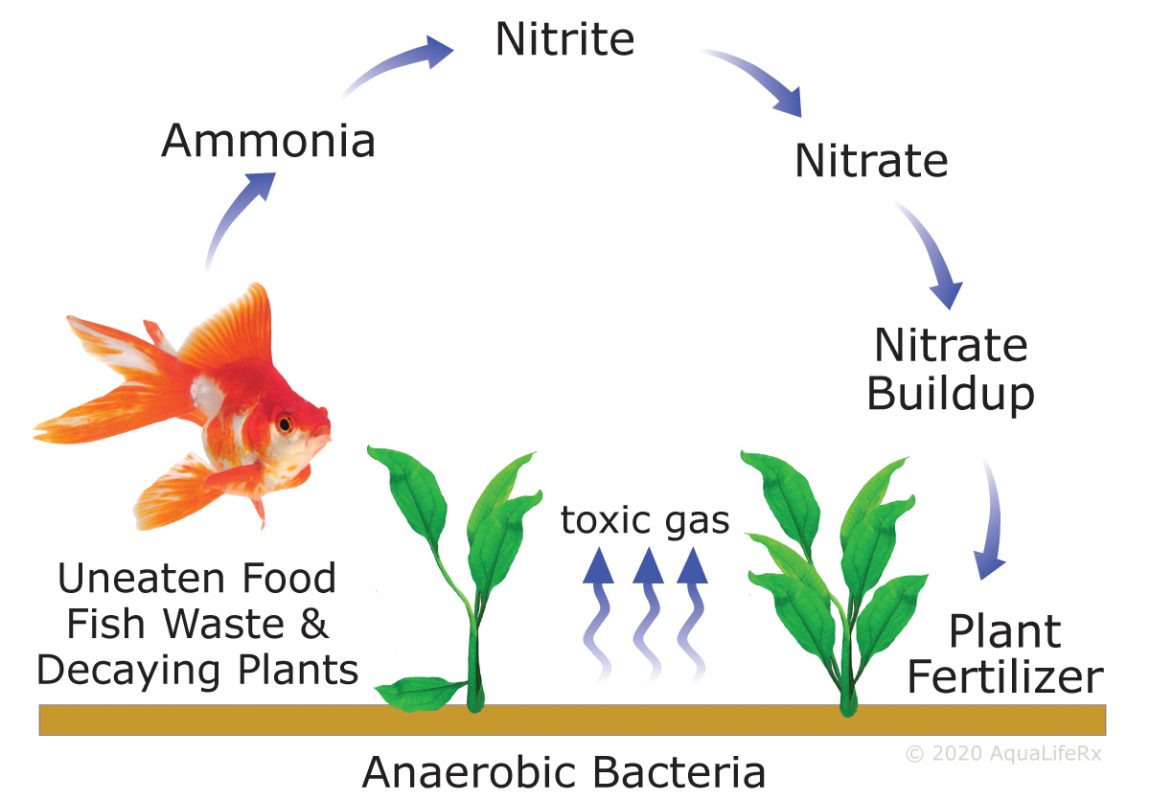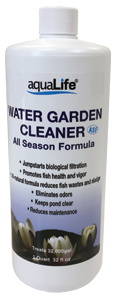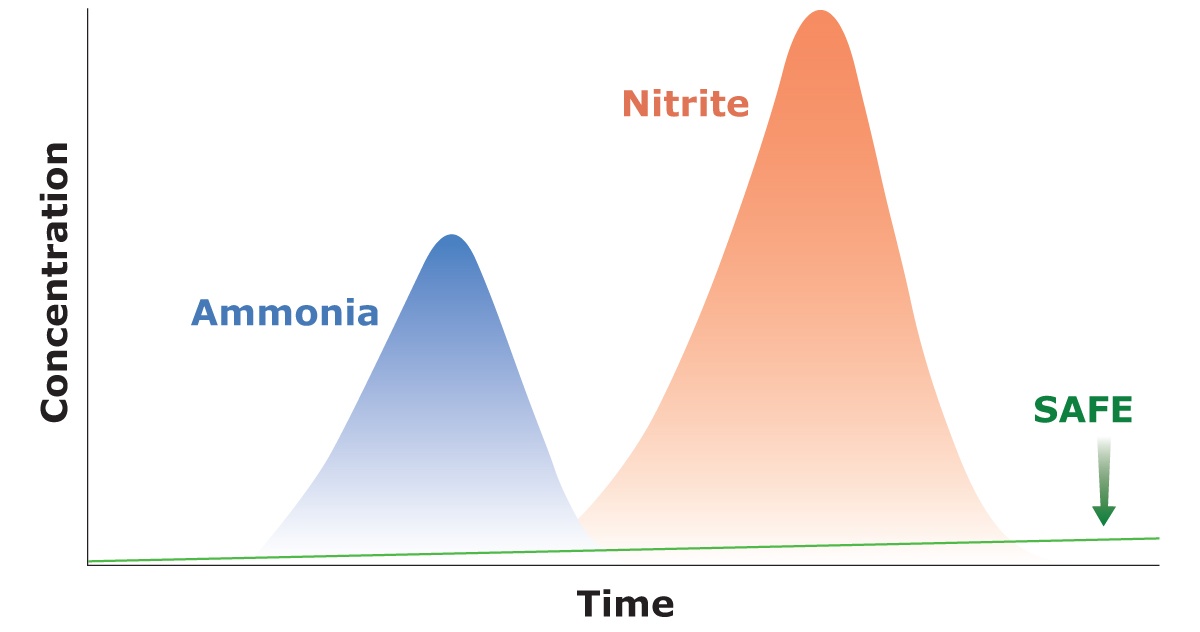17. Understanding the Nitrogen Cycle
Every hobbyist setting up a tank or pond for the first time has heard salespeople refer to the ‘nitrogen cycle’ or ‘cycling’ the water. A good understanding of the nitrogen cycle helps get a tank or pond off to a good, healthy start, and saves money in fish losses and time dealing with the problems that can occur. Knowledge of this important process helps keepers anticipate and troubleshoot problems over the entire life of the tank or pond.
The nitrogen cycle is a naturally occurring process that enables all bodies of water – fresh, salt, or brackish – to sustain animal life over time. It is a dynamic process occurring in all oceans, lakes, streams, ponds, and aquariums worldwide. Unlike animals that live on land and can move away from the wastes they produce, fish and other aquatic life are trapped in the environment with their wastes. Without some kind of process to handle toxic animal waste, all aquatic life would eventually succumb to these poisons. Day in and day out, this beautiful dance of biochemistry sustains all aquatic life on earth.

The nitrogen cycle is the means by which wastes are broken down to less harmful substances. Toxins from accumulated wastes affect a fish’s ability to take oxygen from the water, its ability to convert food to muscle, its ability to ward off disease, and even its ability to swim. The most common and deadly wastes in aquarium water, ammonia and nitrite, originate from the fish themselves, dead animals, and from uneaten food.
How does the Nitrogen Cycle work?

The nitrogen cycle is driven by two species of bacteria, Nitrosomonas and Nitrobacter. These organisms live on the surfaces of rocks, plants, gravel, and sand, and use waste from animals and plants as an energy source. Without these two vital organisms, aquatic creatures would quickly pollute their environment and die. Although the exact nature of the conversions is not completely understood, Nitrosomonas and Nitrobacter appear to break down ammonia to its by-product, nitrite, then nitrite to nitrate. Nitrate at low concentrations is fairly harmless.
As fish are introduced into a new pond, they begin to release waste into the water in the form of excrement and body secretions. These both contain ammonia. Ammonia, in even low concentrations, is very toxic to fish. It damages their gills and inhibits the flow of oxygen to the fish’s tissues. In a new tank, populations of Nitrosomonas and Nitrobacter have not had time to reach sufficient numbers to completely eliminate high concentrations of ammonia and nitrite.
Nitrosomonas and Nitrobacter grow slowly at first, then have a rapid growth and reproduction phase. They eventually level off to numbers needed in the tank to handle the waste of many fish. The numbers of bacteria will eventually be balanced against the amount of waste produced by a given population of fish. Introducing new fish, an outbreak of disease, or an interruption in filtration can disrupt this balance and the bacterial populations will play ‘catch up’ until the balance is restored.
Since the nitrogen cycle begins slowly, fish should be added to the pond slowly. A new system overwhelmed with fish is also overwhelmed with ammonia. Deaths occur when too many fish are producing too much waste and the beneficial bacteria have not reached sufficient levels to handle the load. Select a few hardy, inexpensive fish at first. Then, be patient, feed very carefully, and let the nitrogen cycle get the tank or pond. This will get things ready for more expensive or nicer fish.
Adding Bacterial Cultures
Many commercial bacterial preparations are available to ‘jump start’ the cycle. Cultures introduce huge populations of Nitrosomonas, Nitrobacter, and other cleansing agents to eliminate pollutants and enhance the conversion of ammonia. Some preparations are specifically for freshwater, while others are specific to saltwater systems. Adding cultures to a new system and each time new fish are introduced, or at the first sign of problems, ensures adequate numbers of bacteria to help keep the system free of ammonia and nitrite.

AquaLife Water Garden Cleaner ASF

AquaLife Water Garden Cleaner contains 5 species of beneficial pond bacteria which help eliminate fish waste, excess fish food, toxic ammonia and nitrite, problem-causing nitrate and phosphate, and odors. Use when stocking a new pond with fish, adding fish to an established pond, and as part of routine pond maintenance.
AquaLife Water Garden Cleaner ASF, 32oz
AquaLife Water Garden Cleaner, 1gal

Filter, filter, filter!
Filtration can determine the success or failure of an aquatic system. Poor filtration leads to stress, disease, and fish loss. Filtration encompasses two main ideas: greater surface area and water movement. The bacteria that break down harmful ammonia and nitrite live on substrate or surfaces, such as gravel, rocks, plants, soil, even the fish themselves. Quality filters are designed to incorporate large amounts of ‘media’ that is folded or compacted into a small space. Media significantly increase surface material to support greater numbers of beneficial bacteria. Nitrosomonas and Nitrobacter require oxygen to break down wastes. Adequate water movement, which physically breaks the surface of the tank or pond, delivers vital oxygen to these bacteria living on the surfaces below the water. Adequately filtered water that passes over the fishes’ gills is ammonia-free and the system is teeming with healthy life.
Choosing a Good Filter
All filters are not created equal. Good filtration provides abundant surface area to support populations of bacteria. It also supports a pump that moves enough water to completely recirculate every 3-6 hours. Price is always a factor, so careful consideration should be given to the health of the tank or pond over its entire life. This will protect from potential losses in fish and other animals. The old adage “an ounce of prevention . . “. cannot be stressed enough. A still or inadequately filtered tank or pond is awaiting disaster. Choosing the right filtration system requires good information and good advice. Start at the ‘top-of-the-line’ and work down to the best system you can afford, carefully weighing features against price.
See Filtration and Pond Filters

Water Tests

The nitrogen cycle does not begin until fish are introduced to the system. With no food source, Nitrosomonas and Nitrobacter cannot grow and reproduce. Begin testing the water after a week or two once fish are added. Testing tracks the conversion of ammonia and nitrite as the bacteria perform their duties. This can identify filtration problems early on in the process. Water that reads ammonia and/or nitrite longer than expected in a new system, or consistently reads low levels over time, is an indication of inadequate filtration.
Test, or have your water tested, frequently in the beginning by trustworthy salespeople and listen to their advice. The nitrogen cycle is established when water tests read 0 ammonia and nitrite. This means the system is stable enough to accept a few new fish. As the system ages, perform regular maintenance and continue to test the water at regular intervals to gauge the status and to identify potential problems. Again, patience and diligence at each stage is a virtue that pays off again and again.
